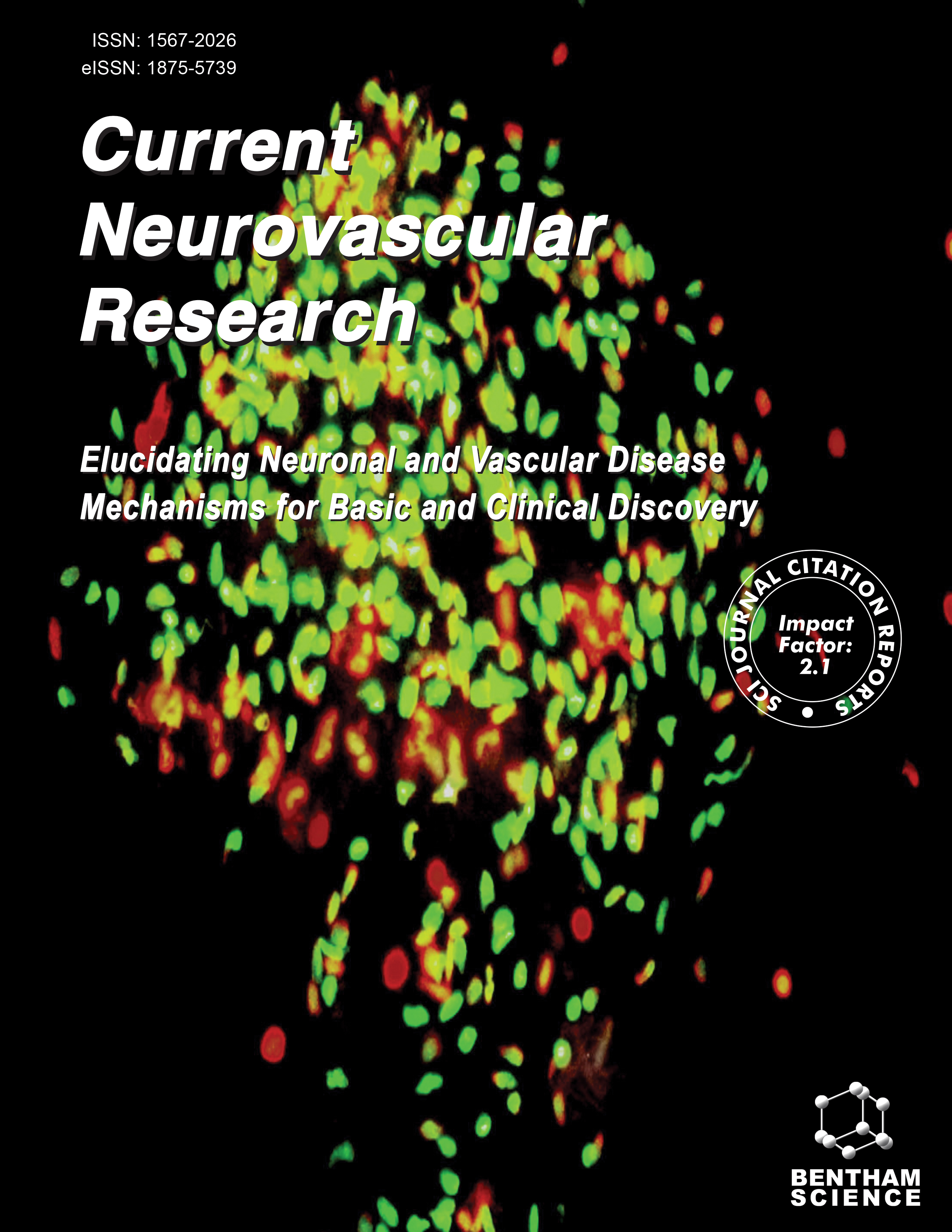- Home
- A-Z Publications
- Current Neurovascular Research
- Previous Issues
- Volume 7, Issue 2, 2010
Current Neurovascular Research - Volume 7, Issue 2, 2010
Volume 7, Issue 2, 2010
-
-
Experimental Diabetes Mellitus Down-Regulates Large-Conductance Ca2+- Activated K+ Channels in Cerebral Artery Smooth Muscle and Alters Functional Conductance
More LessAuthors: Yan Wang, Hong-Tao Zhang, Xing-Li Su, Xiu-Ling Deng, Bing-Xiang Yuan, Wei Zhang, Xin-Feng Wang and Yu-Bai YangCerebral vascular dysfunction and associated vascular complications often develop over time in type-2 diabetes, but the underlying mechanisms are not wholly understood. The aim of the present study was to investigate whether large-conductance Ca2+-activated K+ (BKCa) channels in cerebral artery smooth muscle cells (CASMCs) were impaired in experimental model of type-2 diabetes, and the changes could account Read More
-
-
-
Ginsenoside RB1 Reduces Neurologic Damage, is Anti-Apoptotic, and Down-Regulates p53 and BAX in Subarachnoid Hemorrhage
More LessAuthors: Yingbo Li, Jiping Tang, Nikan H. Khatibi, Mei Zhu, Di Chen, Weiping Zheng and Shali WangStroke is the second leading cause of death worldwide and the number one cause of adult disability in the United States and Europe. A subtype of stroke, subarachnoid hemorrhage (SAH), accounts for 7% of all strokes each year and claims one of the highest mortalities and morbidities. Many therapeutic interventions have been used to treat brain injury following SAH but none have reached the level of effectiveness needed to Read More
-
-
-
Early Apoptotic Vascular Signaling is Determined by Sirt1 Through Nuclear Shuttling, Forkhead Trafficking, Bad, and Mitochondrial Caspase Activation
More LessAuthors: Jinling Hou, Zhao Zhong Chong, Yan Chen Shang and Kenneth MaieseComplications of diabetes mellitus (DM) weigh heavily upon the endothelium that ultimately affect multiple organ systems. These concerns call for innovative treatment strategies that employ molecular pathways responsible for cell survival and longevity. Here we show in a clinically relevant model of DM with elevated D-glucose that endothelial cell (EC) SIRT1 is vital for the prevention of early membrane apoptotic phosphatid Read More
-
-
-
Contribution of Mast Cells to Cerebral Aneurysm Formation
More LessAuthors: Ryota Ishibashi, Tomohiro Aoki, Masaki Nishimura, Nobuo Hashimoto and Susumu MiyamotoCerebral aneurysm (CA) has a high prevalence and causes a fatal subarachnoid hemorrhage. Although CA is a socially important disease, there are currently no medical treatments for CA, except for surgical procedures, because the detailed mechanisms of CA formation remain unclear. From recent studies, we propose that CA is a chronic inflammatory disease of the arterial walls and various inflammation-related factors parti Read More
-
-
-
Sublethal Total Body Irradiation Leads to Early Cerebellar Damage and Oxidative Stress
More LessAuthors: Li Cui, Dwight Pierce, Kim E. Light, Russell B. Melchert, Qiang Fu, K. Sree Kumar and Martin Hauer-JensenThe present study aimed at identifying early damage index in the cerebellum following total body irradiation (TBI). Adult male CD2F1 mice (n=18) with or without TBI challenge (8.5 Gy irradiation) were assessed for histology and expression of selected immunohistochemical markers including malondiadehyde (MDA), 8-hydroxy-2'-deoxyguanosine (8-OHdG), protein 53 (p53), vascular endothelial growth factor receptor 2 (VEGF- Read More
-
-
-
Leptin Reduces Infarct Size in Association with Enhanced Expression of CB2, TRPV1, SIRT-1 and Leptin Receptor
More LessAuthors: Yosefa Avraham, Neta Davidi, Moran Porat, David Chernoguz, Iddo Magen, Lia Vorobeiv, Elliot M. Berry and Ronen R. LekerBrain ischemia is associated with detrimental changes in energy production and utilization. Therefore, we hypothesized that leptin, an adipokynin hormone protecting against severe energy depletion, would reduce infarct volume and improve functional outcome after stroke. Male Sabra mice underwent permanent middle cerebral artery occlusion (PMCAO) by photothrombosis. Following initial dose-response and time-window e Read More
-
-
-
CD133 Expressing Pericytes and Relationship to SDF-1 and CXCR4 in Spinal Cord Injury
More LessCompression injury to the spinal cord (SC) results in vascular changes affecting the severity of the primary damage of the spinal cord. The recruitment of bone marrow (BM)-derived cells contribute to revascularization and tissue regeneration in a wide range of ischemic pathologies. Involvement of these cells in the vascular repair process has been investigated in an animal model of spinal cord injury (SCI). Temporal g Read More
-
-
-
Small Heat Shock Proteins: Recent Advances in Neuropathy
More LessAuthors: Liuwang Zeng, Zhiping Hu, Wei Lu, Xiangqi Tang, Jie Zhang, Ting Li and Binbin YangSmall heat shock proteins(sHSPs), with a small molecular mass of 12-43 kDa, are molecular chaperones that protect cells against stress by assisting them in the correct folding of denatured proteins and thus prevent aggregation of misfolded proteins. During the past several years, there has been an increasing interest in the relationship between sHSPs and neuropathy. sHSPs have emerged as a particularly potent neuroprote Read More
-
Volumes & issues
-
Volume 21 (2024)
-
Volume 20 (2023)
-
Volume 19 (2022)
-
Volume 18 (2021)
-
Volume 17 (2020)
-
Volume 16 (2019)
-
Volume 15 (2018)
-
Volume 14 (2017)
-
Volume 13 (2016)
-
Volume 12 (2015)
-
Volume 11 (2014)
-
Volume 10 (2013)
-
Volume 9 (2012)
-
Volume 8 (2011)
-
Volume 7 (2010)
-
Volume 6 (2009)
-
Volume 5 (2008)
-
Volume 4 (2007)
-
Volume 3 (2006)
-
Volume 2 (2005)
-
Volume 1 (2004)
Most Read This Month
Article
content/journals/cnr
Journal
10
5
false
en


